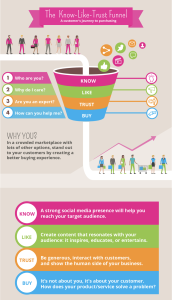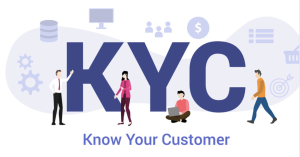While I was driving to a client’s business the other day, a song came on the radio that I thought would be appropriate for a good blog. The song was “Why Can’t We Be Friends?” by WAR (https://www.youtube.com/watch?v=OHmmjnEdtx8)
At first, I thought: “what a great theme song for Facebook” <for obvious reasons>. But, then I thought about business and the KLT-factor (Know, Like & Trust).
ARE YOU A BAD FRIEND TO YOUR CUSTOMERS?
 Getting to Know You
Getting to Know You
This is when customers first hear about your company, your brand story and what you sell. Making a great first impression is important. So where do people get to know your company?
- Print and digital advertising
- Earned media (print and digital articles/blogs/social media posts about your company)
- Social media
- Referral from friends or family
All of these areas lay the foundation for converting potential customers into returning customers.
 Getting to Like You
Getting to Like You
At this stage, people are getting to know your company. This could be anything from your elevator pitch at a booth to a customer walking into your store or clicking a link that directs them to your website. It’s your chance to show the customer who you are, what you believe in, and why they should buy from you – because as we established, they could just as easily buy a similar product elsewhere.
Where do people begin to like your brand online?
- Website – don’t forget to include an “about us” page!
- Blog
- Newsletter
- Social media
At this stage, it’s important that you convey to customers how your product/service can make their lives better, easier, more beautiful, more creative, or some other enhancement.
Getting to Trust You
How do you build trust with people you meet outside of business? By being genuine, likeable, and generous. The same rules apply in marketing, so make your messaging about the consumer: connect with them on a personal level, provide value to them, and show them that you understand their pain points. Where can you build trust with potential customers?
- Tutorials
- Testimonials (on your website, in social media posting, in the form of reviews)
- Newsletter
- Endorsements from people your customers already trust
Of course, there are overlaps between all of these categories, and many instances where these stages can combine. Also keep in mind that converting from liking to trusting may take a long time and require many exposures.
 It’s important to remember that good friendships go both ways – you get to know your friend, and they get to know you. For a personalized marketing experience, you should provide the same experience to your customers. Tell them about you and your brand, your values, but also communicate that you understand their pain points, their passions, and provide them with solutions (your product/service).
It’s important to remember that good friendships go both ways – you get to know your friend, and they get to know you. For a personalized marketing experience, you should provide the same experience to your customers. Tell them about you and your brand, your values, but also communicate that you understand their pain points, their passions, and provide them with solutions (your product/service).
When planning your marketing strategy, you should consider people at each stage of the know-like-trust funnel. How does your content engage and bring people further into the funnel? What are you doing to increase brand awareness to invite more people along this path?
How to Implement a Personalized Marketing Strategy
Clearly, knowing your target audience and tailoring your marketing strategy to their needs can make an impact for your business. In most industries, it’s safe to assume that your target customer is “X” – but within these categories, there are plenty more niches to explore.
A great way to get started is by creating a customer avatar. Think about your ideal customer, then ask yourself:
- How old are they?
- Where do they live?
- What are their passions?
- What inspires them?
- What do you think their annual income is?
- Where do they go on vacation?
- What does their house look like?
 All the things you probably know about your friends, you should know about your ideal consumer. Give them a name, then create marketing material that they’ll love: photos, tutorials, newsletters, social media posting, should all be customized to them, your ideal consumer.
All the things you probably know about your friends, you should know about your ideal consumer. Give them a name, then create marketing material that they’ll love: photos, tutorials, newsletters, social media posting, should all be customized to them, your ideal consumer.
You’re also likely to have more than one ideal consumer. Maybe your consumers include millennial, gen X and baby boomer women. How do you market to all of them effectively? The short answer, is, you don’t. Although there may be overlaps in what they find beautiful (like your product), the answer is that customers in such different stages of their lives, with different life experiences, won’t feel connected with the same language or imagery.
Back when people used to shop in person or order on the phone, they had a more personal shopping experience: you’d talk to a real person, and they’d ask you about what you were looking for, and your specific concerns. The arrival of the internet has radically changed the marketplace, but customers still crave this personalized experience. If a small business wants to succeed, not only does it need to be where its customers are, it needs to give them exactly what they’re looking for. With 10,000 options for your product, at any given time, how are you going to set yourself apart?

 317-289-4965
317-289-4965